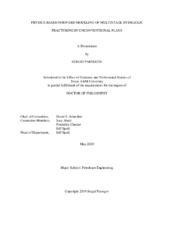| dc.contributor.advisor | Schechter, David | |
| dc.creator | Parsegov, Sergei | |
| dc.date.accessioned | 2019-08-12T13:08:21Z | |
| dc.date.available | 2019-08-12T13:08:21Z | |
| dc.date.created | 2019-05 | |
| dc.date.issued | 2019-03-07 | |
| dc.date.submitted | May 2019 | |
| dc.identifier.uri | https://hdl.handle.net/1969.1/177753 | |
| dc.description.abstract | This dissertation proposes a workflow for modeling of multistage hydraulic fracturing stimulation in unconventional formations. Based on the field case of a horizontal well targeted lower Wolfcamp formation in Midland Basin, this study identifies main gaps of publicly available data and provides estimations for critically important inputs: elastic properties, horizontal stress anisotropy, and pressure dependent leakoff.
Breakdown and shut-in pressure are used to constrain horizontal stress anisotropy to a narrow range of 7.6-11.0% and avoid misleading published data for the Midland Basin. The developed model shows that oilfield operators can significantly, up to two times, reduce the size of the pad and associated cost without risk of streenout. From the estimation of friction losses and modeling in planar-3D model this work shows how to overcome adverse effects of stress shadowing by perforation redesign and reduce cluster spacing.
Finally, fracture conductivity and production history are used to model fluid flow in two reservoir simulators. History match demonstrates that effective permeability should be several orders of magnitude higher than measured from the pressure pulse decay method.
This dissertation will be useful for completion and reservoir engineers.Even though theories of fracture growth in elastic medium are known for decades, multiple field observations show limitations in their predictive power. Therefore operators tend to use descriptive, data-driven models, to further optimize completion design.
This dissertation identifies gaps and misconceptions in hydraulic fracturing design and shows both the benefits and limitations of grid-based fracturing models. More importantly, it demonstrates a workflow for fracture modeling based on a limited amount of publicly available data and practical recommendations for completion redesign coming from observation from physics-driven modeling.
This dissertation will be useful for completion engineers and geomechanical lab scientists. | en |
| dc.format.mimetype | application/pdf | |
| dc.language.iso | en | |
| dc.subject | Stress anisotropy | en |
| dc.subject | Hydraulic fracturing | en |
| dc.subject | Unconventionals | en |
| dc.subject | Permian Basin | en |
| dc.subject | Liquid Rich Reservoirs | en |
| dc.subject | Wolfcamp | en |
| dc.subject | Pressure Dependent Leakoff, Stress Shadowing | en |
| dc.subject | Modeling Workflow | en |
| dc.subject | Perforation Design | en |
| dc.title | Physics-Based Forward Modeling of Multistage Hydraulic Fracturing in Unconventional Plays | en |
| dc.type | Thesis | en |
| thesis.degree.department | Petroleum Engineering | en |
| thesis.degree.discipline | Petroleum Engineering | en |
| thesis.degree.grantor | Texas A & M University | en |
| thesis.degree.name | Doctor of Philosophy | en |
| thesis.degree.level | Doctoral | en |
| dc.contributor.committeeMember | Spath, Jeffrey | |
| dc.contributor.committeeMember | Abedi, Sara | |
| dc.contributor.committeeMember | Chester, Frederick | |
| dc.type.material | text | en |
| dc.date.updated | 2019-08-12T13:08:22Z | |
| local.etdauthor.orcid | 0000-0002-9096-4836 | |


